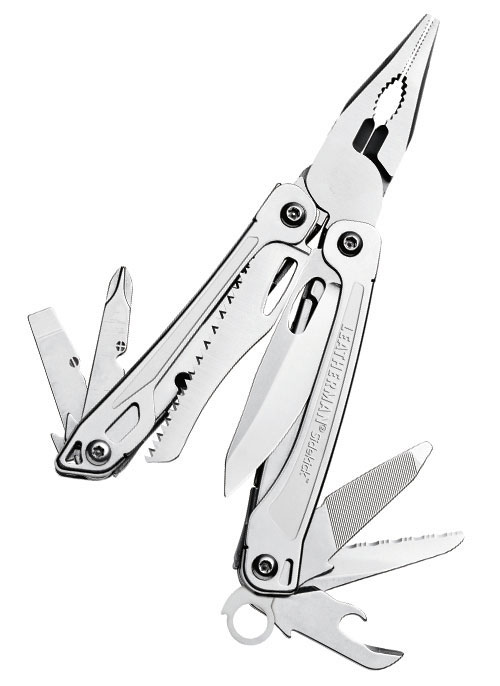 Leatherman is the only manufacturer of foldable, all-in-one multi-tools to build all of those products in the U.S. Its CEO plans to keep it that way.
Leatherman is the only manufacturer of foldable, all-in-one multi-tools to build all of those products in the U.S. Its CEO plans to keep it that way.
BY RON KNOX
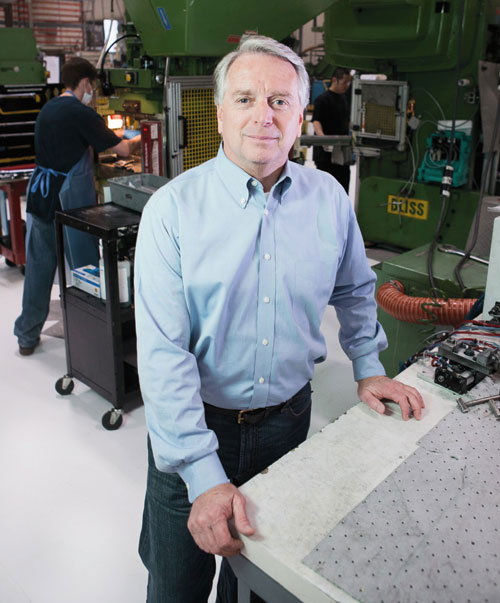 |
Photo by Katharine Kimball |
It’s just after 10 a.m. on a Wednesday, and, if for only a moment, the 90,000-square-foot Leatherman factory, nestled along a winding road in industrial north Portland, is quiet. Of the tool company’s 550-plus employees, those working the early, 4 a.m. shift are nearing the end of their lunch break. Now is the time to stretch.
Up and down the factory’s white and gray concrete walkways, the Leatherman workers stand in semi-circles and bend, crack necks, pull back on hands to help loosen tight wrists. Some folks hold their arms straight out from their sides and swing them in little circles — the fitness technique de jour of mall walkers the world over.
The stretch breaks are crucial. They are, of course, beneficial for the workers. Necessary, even. But these stretching sessions also help ensure bright eyes and loosened limbs, ready to take part in a manufacturing operation that absolutely must be as efficient and productive and lean as possible.
| Leatherman |
| President and CEO: Jake Nichol |
| Employees: 380 |
| Estimated annual revenue: More than $80 million |
| Founded: 1983 |
| Scope: 36 products are sold in 85 countries |
In a world filled with tool companies making Leatherman-type tools using far less expensive labor, Leatherman stands alone. The company’s production facility is the only remaining manufacturer of foldable, all-in-one multi-tools to build all of those products in the U.S. While its competitors can sell their products on department store racks for 20 bucks, Leatherman tools are often kept in locked cases, with each selling for upwards of $100. The competitive disadvantage is stark.
But Jake Nichol, the president and CEO, has been here before. And he has a plan.
“We have a pretty good idea as to how you can compete with the world from a high-wage area like Portland,” Nichol says.
To remain relevant in an economy where price often trumps quality, the company has implemented a deep and indeed proprietary program aimed at streamlining costs and efficiencies in every aspect of the business — from the sourcing of its parts, to its in-house manufacturing and assembly processes, to when and how it looks outside of its own operation for help. The goal, Nichol says, is a simple one: To compete at the same price point as Leatherman’s competition, all while building their tools just a tick south of the Columbia River.
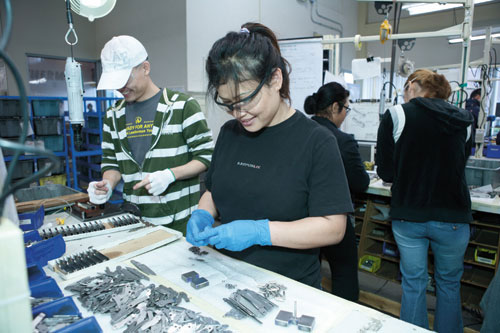 |
Workers are divided into pods shaped in a “U,” with each pod dedicated to a specific product. This process is part of the highly efficient manufacturing process. // Photos by Katharine Kimball |
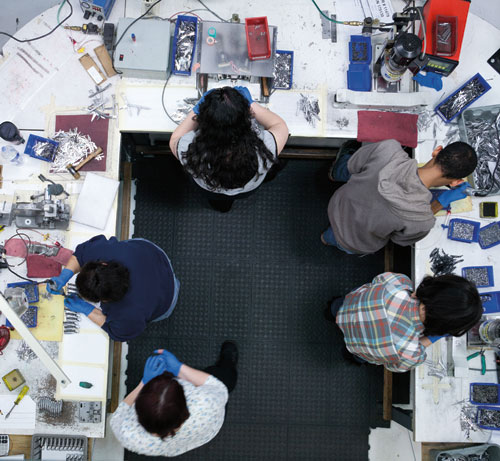 |
It’s a late winter day, and Jake Nichol is between places. For the past week or so, the 58-year-old has been in Asia at a trade show, trying to pry open new markets for the company’s growing array of multi-tools. Tomorrow he’s off to Germany to put the final touches on a deal that will see Leatherman take over German flashlight maker LED Lenser.
But for now, Nichol is pacing the production floor of the Leatherman complex, just a touch jetlagged, comfortable in CEO-cum-everyman jeans and blue tartan shirt, cowboy boots clacking against the painted concrete. Around every corner, he points at some piece of the Leatherman production program needed to compete and grow the company’s market share.
He points at an assembly table where three people stand in a kind of pod, attaching knife blades to fasteners. That, Nichol says, is an example of the Toyota-inspired production methods Leatherman prefers: an efficient, almost singular motion from one phase of production to another. Its employees work as close-knit teams. Spreadsheets hang from each pod, charting out production goals, whether those goals were met and, if the group fell short, why that particular pod struggled.
The system is designed to weed out those things that American manufacturers can’t afford: inefficiencies, waste and inconsistencies. The process, which the company unabashedly calls the Leatherman Operating System, combines lean manufacturing and management techniques designed to wring every last drop of efficiency out of the production process.
The company’s lean manufacturing process, based on the Toyota Production System model that has been touted for decades as the best in the business, is apparent. It’s part of everything Nichol points out as he walks the Leatherman production floor. But the “breakthrough management” style Nichol has adopted to help lower costs is slightly more curious.
The management style, named after a Japanese leadership technique developed by management expert Shoji Shiba, preaches breakthroughs in business as a way to survive in a rapidly globalizing world. At Leatherman, the philosophy has meant establishing two or three key goals every year toward which the company invests serious time and resources — goals that would require the company, as Nichol puts it, “to completely change the context, and rethink the whole methodology of what you’ve done.”
Two years ago, for example, Nichol challenged his team to develop a multi-tool that would sell for a paltry $30 – exactly what the company’s competitors were selling their tools for, even though they were made in China for far less.
“We challenged our teams, and said: Rethink all that you do, and find a way to get to those kind of cost take-out levels.”
Factory workers on the Leatherman floor couldn’t just work harder or longer hours; that wasn’t enough. It took a close examination of costs throughout the proposed product and some real critical thought about every step of manufacturing. The jaws of the tool would have to be made a totally different way. Some subcontracted work had to be brought in-house to cut costs.
Once every month after Nichol challenged his team, the company conducted rigorous analysis of the tool’s development, looking at potential costs and savings to gauge how close they were to hitting their proposed price point. Eventually, the breakthrough came. Nichol’s team found a way to rework their system to cut costs at every step. The new $30 multi-tool was officially announced at a trade show in February, and will hit store shelves in September.
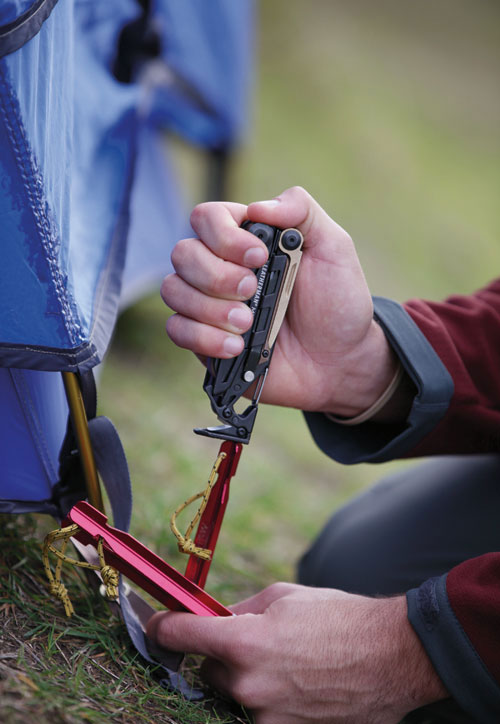 |
Leatherman’s multi-tools are used in a wide range of activities, from camping to bike repair. |
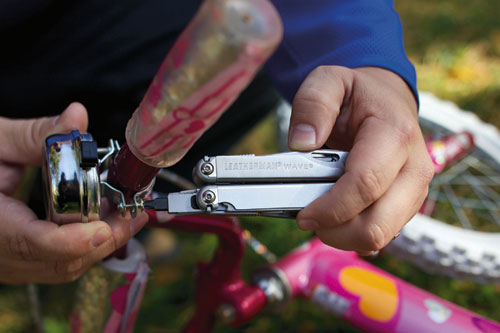 |
So the question arises: Why go through all this? All of Leatherman’s major competitors have moved at least part of their multi-tool production overseas, where labor costs are considerably less. Rather than spending the time and effort to re-jig the way the company runs its business, why not contract the work — or part of it, anyway — to a facility on the other side of the Pacific?
The answer is simple: Six years go, Jake Nichol made a promise, and a gambit.
In 2004, the company’s venerable founder and chairman, Tim Leatherman, came to a realization: He wasn’t very good at strategic planning. Leatherman had done a lot for his company. He invented the first multi-tool — first called “Mr. Crunch” and later “Pocket Survival Tool” — after a disastrous experience in a Fiat during a 1975 trip to Europe showed him that a simple pocketknife was not enough.
He and co-founder Steve Berliner filled the company’s first order in 1983, for 500 multi-tools to be sold in a Cabela’s catalog. He led the company through its exponential expansion, from those first 500 tools, to a company with 36 products selling millions of units annually in more than 85 countries around the world. The company now reports more than $80 million annually in gross revenues. It says that after a difficult 2008, revenue grew 18% during the past fiscal year.
But strategic planning was not his forte, Leatherman, 62, says now. “I thought we had a strategic plan, but the employees couldn’t recall the meetings,” he says. “Because there weren’t any.”
In 2004, at the company’s first strategic planning session, Leatherman was on the verge of stepping down from full-time duties at the company. He included in the plan a list of what he called the company’s “guiding principles.” Chief among them was a pledge to keep the company, and its manufacturing plant, in Portland for as long as possible.
Those principles became a kind of contract for the company’s next chief executive. If a candidate agreed to adhere to the plan, they’d talk. If not, there was nothing more to discuss.
Leatherman set up an interview with Nichol, who brought with him a quarter-century’s worth of experience of the tool industry, both at Stanley and at Danaher, the Washington, D.C.-based group that makes tools for Sears under the Craftsman brand. At Danaher, Leatherman says, Nichol was in much the same position, having to devise ways to make hand tools in the U.S. when many rivals had moved production elsewhere.
Nichol agreed to follow Leatherman’s principles — and to take the job. That agreement has shaped the way the company has operated ever since.
So the company’s disadvantage is a permanent one, at least as permanent as such things get. Nichol and Leatherman both say that the pledge to remain in Portland presents obvious challenges — balancing quality and cost, always fending off competitors that offer good concepts at often-lower prices.
But Nichol says the pledge has been a kind of blessing as well. The jobs the company provides in Portland are, in a way, its promise to the area, something Leatherman, a native Oregonian, cherishes. With the agreement between Leatherman and Nichol in place, those promises can be kept. Company executives tell employees, government leaders and suppliers that it’s going to stay here. It’s empowering, Nichol says.
“The empowering part of that is that there are no off-ramps,” he says. “There’s no ‘If this doesn’t work we’ll go do such and such.’ It’s really helped us build a clear business strategy.”
The endless battle against costs and inefficiencies continues. Two years ago, it was a plan to make a $30 multi-tool. That plan has come to fruition. But Nichol says every year comes with new plans, and with them, new ideas about how to squeeze waste from the company and new, faster, more efficient work habits to embrace. From Nichol down to the workers on the factory floor, it’s again time to stretch.


